-
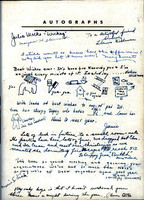 Llenis J. Hillman Scrapbook and other College Memorabilia
Llenis J. Hillman Scrapbook and other College Memorabilia This collection includes photographs and ephemera related to Llenis Hillman's time at RAMI, as well as alumni books and records post-graduation
-
 Bertha E. Butts Sewing Scrapbook and Dress Collection
Bertha E. Butts Sewing Scrapbook and Dress Collection This collection includes the works of Bertha E. Butts, dressmaking student at the Rochester Athenaeum and Mechanics Institute (RAMI) in 1904, along with other information about the Domestic Science Department through which the dressmaking course was offered.
-
 RIT Corner Crew
RIT Corner Crew History of the RIT Corner Crew and its members
-
 RIT Songs
RIT Songs Overview of the history of RIT songs of all sorts with a particular focus on the Alma Mater.
-
 RIT Graphic Marks
RIT Graphic Marks Most students at RIT would never think that their school logo would have any history, especially given that the official logo has been nothing more than the school’s initials for so long. The RIT logo and other graphic marks have an incredibly branching history with numerous one-off designs and other changes, some drastic and some subtle. Even the current school seal harks back to when the school was known as the Rochester Anethaeum and Mechanics Institute. In the past, the graphic marks representing this school were constantly changing, and these changes date all the way back to the downtown campus that RIT started on. RIT and its logo changed with the times, as well as changed randomly. This collection showcases some of the more interesting and influential designs throughout the history of the school.
-
 RIT Class of 1967
RIT Class of 1967 Containing the best of the class of 1967
-
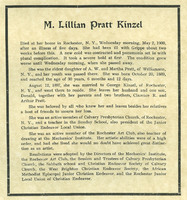 M. Lillian Pratt Kinzel Collection
M. Lillian Pratt Kinzel Collection
-
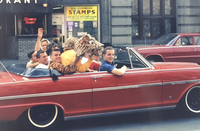 RIT: An Evolution of a Mascot
RIT: An Evolution of a Mascot A history and compendium of information on RIT's mascot, via various formats such as images, a costume, and various descriptions to help the viewer along and provide information.
-
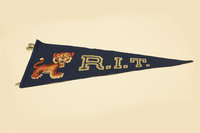 RIT Colors Evolution
RIT Colors Evolution Prior to 1957, RIT’s official colors were blue and grey, and the mascot was the “Techmen.” Following an undefeated basketball season in 1955-1956 however, a desire was struck for a “more collegiate-sounding name,” leading to a 1957 Student Government vote to make the school colors orange, brown, and white. At this point, the mascot also became the RIT Tigers.
However, this decision took a long time to put into effect, and it wasn’t until a 1964 vote by the Policy Committee that the colors were officially changed to Burnt Umber (dark brown), orange hue, and white. These colors were refined further when RIT moved campuses in 1968, and the colors became brown (Pantone 167) and orange (Pantone 165).
Although this timeline can be a bit confusing, the different policy changes, refinement, and committee decisions means that there is a rich collection of memorabilia, clothing, and other items featuring school colors from RIT’s past.
-
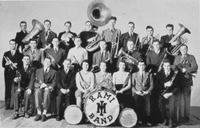 The Rochester Institute of Technology Band Through the Years
The Rochester Institute of Technology Band Through the Years Throughout the history of the Rochester Institute of Technology, one student organized club has maintained its legacy, through reincarnations spanning from the early days of the Rochester Athenaeum and Mechanics Institute to modern day RIT. This organization has been resurrected time and time again through student leadership and interest in the important institution of a University band. Though an exact timeline of the various bands is difficult to pin point what has been easy to understand is the ever present need for such a student organization. From the first images found of an institutional band in the early 1930s, to the supposedly short lived reincarnation in the 40s, on to the widely requested RIT Tiger band, which spanned from 1968 to sometime in the 1990s to early 2000s, followed by the modern day RIT Pep Band. Each of these bands were created by passionate students, who saw a need that was not being met, and chose to do something about it.
-
 Cheerleading at RIT
Cheerleading at RIT A documented timeline of Cheerleaders at RIT from 1943-2006
-
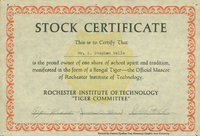 Collection on SpiRIT (Tiger)
Collection on SpiRIT (Tiger) In 1963, a “Tiger Council” made up of RIT students purchased the two-month old Bengal tiger, SpiRIT, to serve as the school’s mascot. While SpiRIT was housed at a local zoo, the tiger was also brought to campus for a variety of events, so that students could interact with their mascot. Students trained as the tiger’s handlers, such as David A. Page (’66), formed particularly close relationships with SpiRIT, which made the animal’s untimely death in 1964 particularly difficult. In 1967, the tiger’s pelt was preserved, so that future generations could also experience the once-living embodiment of Student Pride in RIT.
-
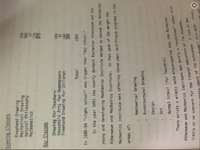 Charting One's Course: The History of Individualized Education at RIT
Charting One's Course: The History of Individualized Education at RIT
-
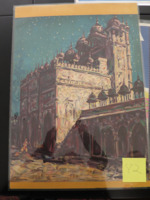 Exploring Southeast Asia through India and Indonesia
Exploring Southeast Asia through India and Indonesia This collection shares a series of travel posters promoting trips to areas throughout India and Indonesia. There are descriptions provided with each poster and external links provided to facilitate a better understanding of Southeast Asia area during the time in which these poster were created and how these countries have changed and developed since.
-
 Dane Gordon Poetry Manuscripts - Notebook 1
Dane Gordon Poetry Manuscripts - Notebook 1 Dane R. Gordon fought in WWII. After he became a minister, a Professor of Philosophy at RIT and a poet. At RIT he also wrote Rochester Institute of Technology: Industrial Development and Educational Innovation in an American City. This collection will focus on his first poetry notebook.
-
Edward H. Butler III
Male child with curly hair looking into the camera, top of head to shoulder shot.
-
 Hannah Barber Collection
Hannah Barber Collection
-
 RIT Archives Collection
RIT Archives Collection RIT Archive Collections consists of four primary collections: RIT Archives, the historically valuable records of the university; RIT/NTID Deaf Studies Archive holds NTID records and acquires collections related to Deaf education, Deaf culture, Deaf theater, technologies related to the deaf and artwork by deaf artists; RIT Art Collection contains works by faculty students and alumni and showcases individual talent and the range of art programs; and RIT Special Collections include the Frederick Wiedman Jr. Presidential Signature Collection as well as two substantial collections of editorial cartoons by Elmer Messner and John Scott Club.
 Llenis J. Hillman Scrapbook and other College Memorabilia This collection includes photographs and ephemera related to Llenis Hillman's time at RAMI, as well as alumni books and records post-graduation
Llenis J. Hillman Scrapbook and other College Memorabilia This collection includes photographs and ephemera related to Llenis Hillman's time at RAMI, as well as alumni books and records post-graduation Bertha E. Butts Sewing Scrapbook and Dress Collection This collection includes the works of Bertha E. Butts, dressmaking student at the Rochester Athenaeum and Mechanics Institute (RAMI) in 1904, along with other information about the Domestic Science Department through which the dressmaking course was offered.
Bertha E. Butts Sewing Scrapbook and Dress Collection This collection includes the works of Bertha E. Butts, dressmaking student at the Rochester Athenaeum and Mechanics Institute (RAMI) in 1904, along with other information about the Domestic Science Department through which the dressmaking course was offered. RIT Corner Crew History of the RIT Corner Crew and its members
RIT Corner Crew History of the RIT Corner Crew and its members RIT Songs Overview of the history of RIT songs of all sorts with a particular focus on the Alma Mater.
RIT Songs Overview of the history of RIT songs of all sorts with a particular focus on the Alma Mater. RIT Graphic Marks Most students at RIT would never think that their school logo would have any history, especially given that the official logo has been nothing more than the school’s initials for so long. The RIT logo and other graphic marks have an incredibly branching history with numerous one-off designs and other changes, some drastic and some subtle. Even the current school seal harks back to when the school was known as the Rochester Anethaeum and Mechanics Institute. In the past, the graphic marks representing this school were constantly changing, and these changes date all the way back to the downtown campus that RIT started on. RIT and its logo changed with the times, as well as changed randomly. This collection showcases some of the more interesting and influential designs throughout the history of the school.
RIT Graphic Marks Most students at RIT would never think that their school logo would have any history, especially given that the official logo has been nothing more than the school’s initials for so long. The RIT logo and other graphic marks have an incredibly branching history with numerous one-off designs and other changes, some drastic and some subtle. Even the current school seal harks back to when the school was known as the Rochester Anethaeum and Mechanics Institute. In the past, the graphic marks representing this school were constantly changing, and these changes date all the way back to the downtown campus that RIT started on. RIT and its logo changed with the times, as well as changed randomly. This collection showcases some of the more interesting and influential designs throughout the history of the school. RIT Class of 1967 Containing the best of the class of 1967
RIT Class of 1967 Containing the best of the class of 1967 M. Lillian Pratt Kinzel Collection
M. Lillian Pratt Kinzel Collection  RIT: An Evolution of a Mascot A history and compendium of information on RIT's mascot, via various formats such as images, a costume, and various descriptions to help the viewer along and provide information.
RIT: An Evolution of a Mascot A history and compendium of information on RIT's mascot, via various formats such as images, a costume, and various descriptions to help the viewer along and provide information. RIT Colors Evolution Prior to 1957, RIT’s official colors were blue and grey, and the mascot was the “Techmen.” Following an undefeated basketball season in 1955-1956 however, a desire was struck for a “more collegiate-sounding name,” leading to a 1957 Student Government vote to make the school colors orange, brown, and white. At this point, the mascot also became the RIT Tigers. However, this decision took a long time to put into effect, and it wasn’t until a 1964 vote by the Policy Committee that the colors were officially changed to Burnt Umber (dark brown), orange hue, and white. These colors were refined further when RIT moved campuses in 1968, and the colors became brown (Pantone 167) and orange (Pantone 165). Although this timeline can be a bit confusing, the different policy changes, refinement, and committee decisions means that there is a rich collection of memorabilia, clothing, and other items featuring school colors from RIT’s past.
RIT Colors Evolution Prior to 1957, RIT’s official colors were blue and grey, and the mascot was the “Techmen.” Following an undefeated basketball season in 1955-1956 however, a desire was struck for a “more collegiate-sounding name,” leading to a 1957 Student Government vote to make the school colors orange, brown, and white. At this point, the mascot also became the RIT Tigers. However, this decision took a long time to put into effect, and it wasn’t until a 1964 vote by the Policy Committee that the colors were officially changed to Burnt Umber (dark brown), orange hue, and white. These colors were refined further when RIT moved campuses in 1968, and the colors became brown (Pantone 167) and orange (Pantone 165). Although this timeline can be a bit confusing, the different policy changes, refinement, and committee decisions means that there is a rich collection of memorabilia, clothing, and other items featuring school colors from RIT’s past. The Rochester Institute of Technology Band Through the Years Throughout the history of the Rochester Institute of Technology, one student organized club has maintained its legacy, through reincarnations spanning from the early days of the Rochester Athenaeum and Mechanics Institute to modern day RIT. This organization has been resurrected time and time again through student leadership and interest in the important institution of a University band. Though an exact timeline of the various bands is difficult to pin point what has been easy to understand is the ever present need for such a student organization. From the first images found of an institutional band in the early 1930s, to the supposedly short lived reincarnation in the 40s, on to the widely requested RIT Tiger band, which spanned from 1968 to sometime in the 1990s to early 2000s, followed by the modern day RIT Pep Band. Each of these bands were created by passionate students, who saw a need that was not being met, and chose to do something about it.
The Rochester Institute of Technology Band Through the Years Throughout the history of the Rochester Institute of Technology, one student organized club has maintained its legacy, through reincarnations spanning from the early days of the Rochester Athenaeum and Mechanics Institute to modern day RIT. This organization has been resurrected time and time again through student leadership and interest in the important institution of a University band. Though an exact timeline of the various bands is difficult to pin point what has been easy to understand is the ever present need for such a student organization. From the first images found of an institutional band in the early 1930s, to the supposedly short lived reincarnation in the 40s, on to the widely requested RIT Tiger band, which spanned from 1968 to sometime in the 1990s to early 2000s, followed by the modern day RIT Pep Band. Each of these bands were created by passionate students, who saw a need that was not being met, and chose to do something about it. Cheerleading at RIT A documented timeline of Cheerleaders at RIT from 1943-2006
Cheerleading at RIT A documented timeline of Cheerleaders at RIT from 1943-2006 Collection on SpiRIT (Tiger) In 1963, a “Tiger Council” made up of RIT students purchased the two-month old Bengal tiger, SpiRIT, to serve as the school’s mascot. While SpiRIT was housed at a local zoo, the tiger was also brought to campus for a variety of events, so that students could interact with their mascot. Students trained as the tiger’s handlers, such as David A. Page (’66), formed particularly close relationships with SpiRIT, which made the animal’s untimely death in 1964 particularly difficult. In 1967, the tiger’s pelt was preserved, so that future generations could also experience the once-living embodiment of Student Pride in RIT.
Collection on SpiRIT (Tiger) In 1963, a “Tiger Council” made up of RIT students purchased the two-month old Bengal tiger, SpiRIT, to serve as the school’s mascot. While SpiRIT was housed at a local zoo, the tiger was also brought to campus for a variety of events, so that students could interact with their mascot. Students trained as the tiger’s handlers, such as David A. Page (’66), formed particularly close relationships with SpiRIT, which made the animal’s untimely death in 1964 particularly difficult. In 1967, the tiger’s pelt was preserved, so that future generations could also experience the once-living embodiment of Student Pride in RIT. Charting One's Course: The History of Individualized Education at RIT
Charting One's Course: The History of Individualized Education at RIT  Exploring Southeast Asia through India and Indonesia This collection shares a series of travel posters promoting trips to areas throughout India and Indonesia. There are descriptions provided with each poster and external links provided to facilitate a better understanding of Southeast Asia area during the time in which these poster were created and how these countries have changed and developed since.
Exploring Southeast Asia through India and Indonesia This collection shares a series of travel posters promoting trips to areas throughout India and Indonesia. There are descriptions provided with each poster and external links provided to facilitate a better understanding of Southeast Asia area during the time in which these poster were created and how these countries have changed and developed since. Dane Gordon Poetry Manuscripts - Notebook 1 Dane R. Gordon fought in WWII. After he became a minister, a Professor of Philosophy at RIT and a poet. At RIT he also wrote Rochester Institute of Technology: Industrial Development and Educational Innovation in an American City. This collection will focus on his first poetry notebook.
Dane Gordon Poetry Manuscripts - Notebook 1 Dane R. Gordon fought in WWII. After he became a minister, a Professor of Philosophy at RIT and a poet. At RIT he also wrote Rochester Institute of Technology: Industrial Development and Educational Innovation in an American City. This collection will focus on his first poetry notebook. Hannah Barber Collection
Hannah Barber Collection  RIT Archives Collection RIT Archive Collections consists of four primary collections: RIT Archives, the historically valuable records of the university; RIT/NTID Deaf Studies Archive holds NTID records and acquires collections related to Deaf education, Deaf culture, Deaf theater, technologies related to the deaf and artwork by deaf artists; RIT Art Collection contains works by faculty students and alumni and showcases individual talent and the range of art programs; and RIT Special Collections include the Frederick Wiedman Jr. Presidential Signature Collection as well as two substantial collections of editorial cartoons by Elmer Messner and John Scott Club.
RIT Archives Collection RIT Archive Collections consists of four primary collections: RIT Archives, the historically valuable records of the university; RIT/NTID Deaf Studies Archive holds NTID records and acquires collections related to Deaf education, Deaf culture, Deaf theater, technologies related to the deaf and artwork by deaf artists; RIT Art Collection contains works by faculty students and alumni and showcases individual talent and the range of art programs; and RIT Special Collections include the Frederick Wiedman Jr. Presidential Signature Collection as well as two substantial collections of editorial cartoons by Elmer Messner and John Scott Club.